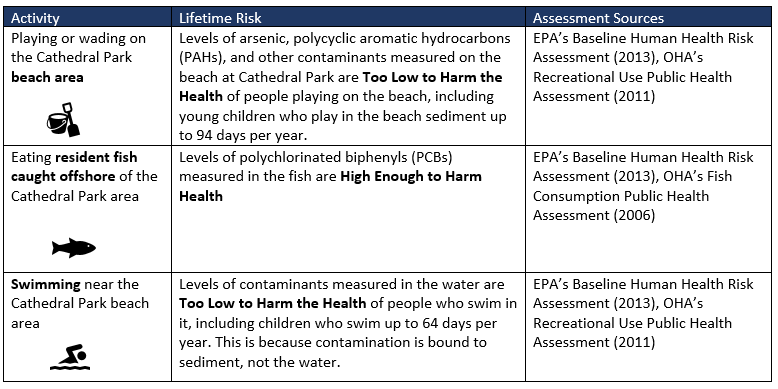Cathedral Park is located between River Mile 4.7 East and 6.5 East within the
Portland Harbor Superfund Site (link), adjacent to the Lower Willamette River. The Park is a heavily used public recreation area for boaters, swimmers, beach goers, and others. Residential housing has recently expanded in nearby neighborhoods, prompting an increase in community questions about the safety of recreating on the beach and in the water near Cathedral Park.
The Oregon Health Authority's
 Environmental Health Assessment Program (EHAP) is collaborating with the Environmental Protection Agency (EPA), Oregon Department of Environmental Quality (DEQ), Multnomah County Health Department, City of Portland, and the National Oceanic and Atmospheric Administration (NOAA) to advise on health risks associated with this site.
Environmental Health Assessment Program (EHAP) is collaborating with the Environmental Protection Agency (EPA), Oregon Department of Environmental Quality (DEQ), Multnomah County Health Department, City of Portland, and the National Oceanic and Atmospheric Administration (NOAA) to advise on health risks associated with this site.
EPA has conducted a risk assessment and EHAP has conducted a public health assessment for the Portland Harbor Superfund Site. Since Cathedral Park is located within the Portland Harbor Superfund Site, the findings from these assessments are representative of both Portland Harbor and Cathedral Park. Both assessments concluded that
consuming resident fish poses the greatest health risks related to the Portland Harbor Superfund Site.
Learn more about
 EPA's Risk Assessment and
EPA's Risk Assessment and
 EHAP's Public Health Assessment
EHAP's Public Health Assessment
Contamination at Cathedral Park Beach
The contamination associated with the Portland Harbor Superfund Site, which includes Cathedral Park, is tightly bound to the sediment (mud) at the bottom of the Lower Willamette River and in the resident fish (species that do not migrate).
Contamination levels in the water are too low to harm health.
EPA sampled the beach sediment at Cathedral Park in 2002. Based on the data, EPA determined that the chemical levels at Cathedral Park Beach do not warrant active cleanup.
Beach recreation poses little risk to human health.
Based on a review of the site history, there are no known sources of contamination at Cathedral Park. This means that EPA's samples from 2002 are still considered representative of the current levels of contamination at Cathedral Park Beach. If additional information becomes available regarding potential sources of contamination, DEQ would reevaluate whether Cathedral Park should be included in its source control program.
Visit
EPA's website (link) and
DEQ's website (link) for current information about investigation and cleanup activities at the Portland Harbor Superfund Site, which includes Cathedral Park.
Health Risks Associated with Cathedral Park
Beach, offshore sediment, and ecological sampling has occurred at Cathedral Park since 2002. EPA will be collecting additional offshore sediment and beach samples during the remedial design phase of the Portland Harbor Superfund Site cleanup.
The table below summarizes health risks identified through previous sampling activities:

Since the City of Portland's Big Pipe project was completed in 2011, combined sewage overflows are rare and occur only at times of year with prolonged periods of heavy rain, when fewer people would be expected to swim. The City of Portland monitors bacteria levels in the water and results are available on their
website (link).
Swimmers should still take normal safety precautions applicable to swimming in any body of water with currents, boat traffic, and other physical hazards.
The Portland Harbor Fish Advisory is in Effect at Cathedral Park
Eating fish is good for you! However, some fish and shellfish in the Lower Willamette River contain harmful substances that make them unsafe to eat.
You should not eat carp, catfish, bass, or clams since these species live their whole lives in the Lower Willamette and are highly exposed to contaminants in the riverbed. Salmon, steelhead, and shad are safe because they spend only a short time in the Lower Willamette River.
If you decide to eat fish from the Lower Willamette River, choose smaller fish with shorter lives and eat in small amounts. A meal is about the size and thickness of your hand. Throw away the head, tail, skin, bone, guts, and fat before eating to reduce your exposure to harmful substances.
Review our
Lower Willamette River Fish Advisory webpage (link) or
 summary fact sheet to learn more. Multnomah County health Department has additional information about the Portland Harbor fish advisory on their
website (link).
summary fact sheet to learn more. Multnomah County health Department has additional information about the Portland Harbor fish advisory on their
website (link).
Related Information